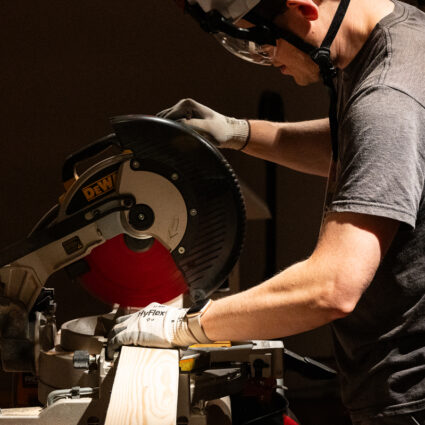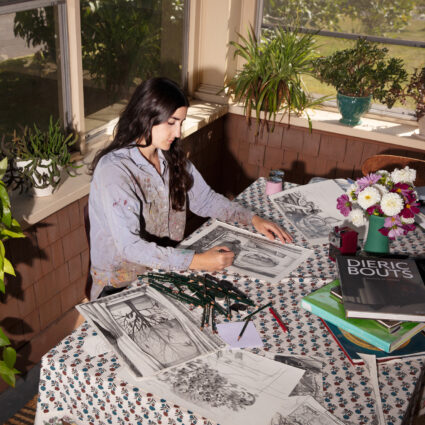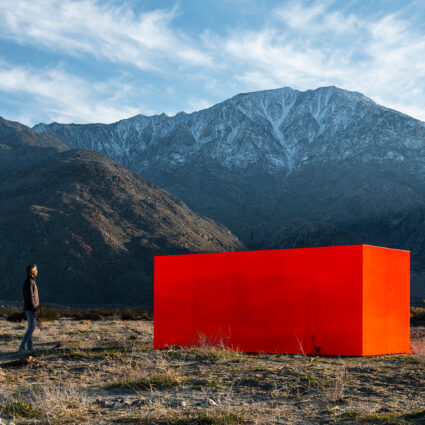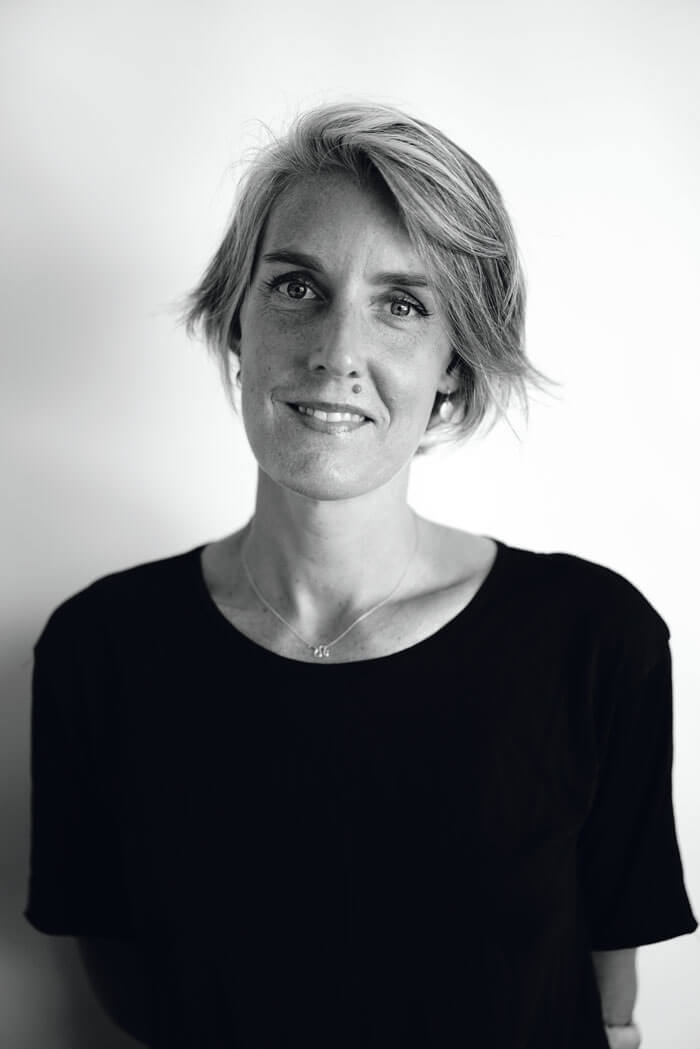
Kate Carr creates minimalist sculptural works working primarily in Baltic birch plywood and wool felt. The structural lines of plywood meet with colorful, stacked pieces of felt with even-handed transparency. Each material supplies Carr with a natural linear quality that she fits together, creating subtle contrasts between the different textures, weights, and palettes. Recently, the artist has been tussling with linearity and playing with the nature of the curve, which has not yet fully manifested in her polyhedral work. Carr, represented by Garvey Simon Art Access in New York and Galleri Urbane in Texas, works out of her home studio in Santa Fe where she took time to show The her space and share her experience of following and experimenting with shifts within her work.
Clayton Porter: Let’s get started with: why Santa Fe?
The sky, I would say. I think it’s one of the most incredible skies I’ve ever seen. I did my undergraduate thesis on Agnes Martin, and I sort of followed her trajectory, studying her and researching her. I became really intrigued with New Mexico—and then started to think about all of these other women who’d come here, like Georgia O’Keeffe, Lucy Lippard, May Stevens, all these artists that had come out here at different times. I visited several times before I finally moved out here. Right after graduate school I got a residency up at the Harwood Museum in Taos. My partner Jenny, a writer, and I were in Iowa and got to come here right from graduate school and live above the Harwood Museum. I got a studio, and we were treated very professionally: “Kate’s an artist, and Jenny’s a writer.” That was such a legitimizing thing to feel right after graduate school. That was a really amazing foray into New Mexico. I went back East right after that for a teaching gig and came back as soon as I could. We fell in love with New Mexico during that residency, and I think part of it was that we were treated very well and treated like artists. We were respected.
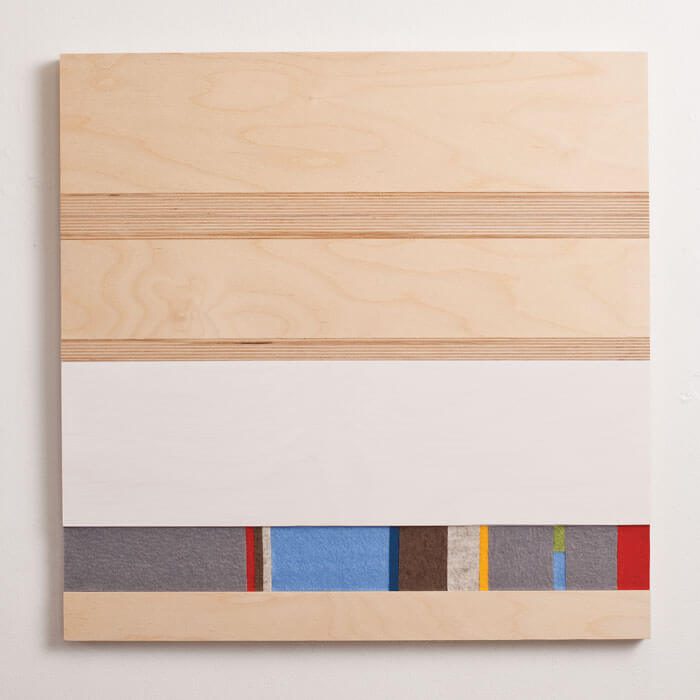
CP: What was your teaching experience like?
I moved back to Vermont to teach at my alma mater, Marlboro College. It’s a tiny little hippie school in southern Vermont. It only has three hundred students. That was a very rewarding experience, to teach where I’d been to school, because I kind of knew the kinds of students that go to that school. I taught a sculpture class that was basically—and this is my favorite way to teach when I’m teaching art—a material exploration class. There was just: “Let’s play with these materials. Let’s play with wood; let’s play with rubber; let’s play with fabric; let’s play with found materials and work out assignments through that.” So it was really fun. We were in Vermont for a year and then came back right after that. And we’ve been in this house in Santa Fe for ten years, which has been really nice. This backyard was just weeds. There was nothing here. I built this studio about five years ago.
CP: What is your practice like—how much time do you spend in the studio? When do you come in here?
It depends on what’s happening. It can be all the time or very little. I seem to work in huge spurts, when I have a lot of deadlines and a lot of activity happening all at once. Then there are more spacious times when I might be in here three or four days a week but not necessarily every day. I try to give myself a little bit of spaciousness around the studio. A lot of this work is very labor-intensive—on my hands, on my body—so I can’t stand every day for hours and hours. I would go crazy. I try to break it up between different kinds of activities. I’ll do standing work for a little while and then go in and do something else. Or I might just do an hour of work, doing varnishing or something, and then stop. It really depends. Before I had the studio, I was just working on sawhorses in the back. I worked in and out of the house: I would just make a studio work however.
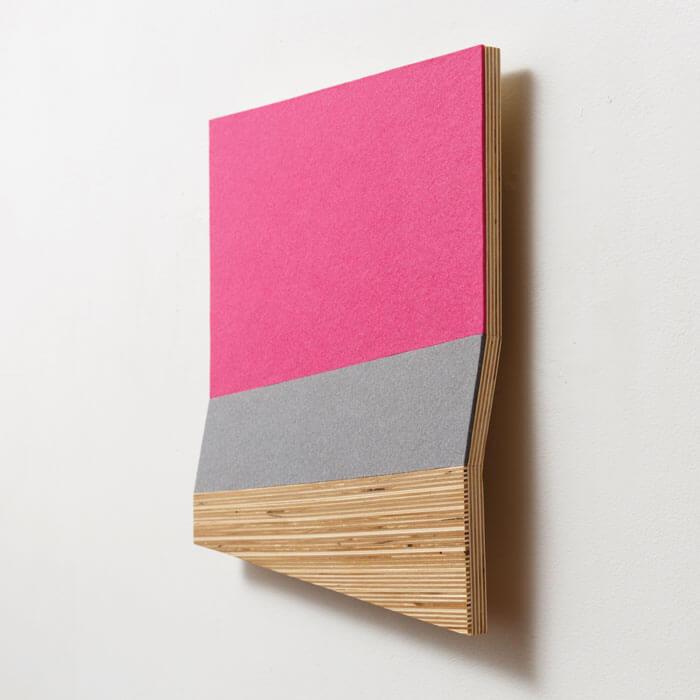
CP: Would you want to upgrade if you could, in terms of the space and the equipment?
Yeah. As soon as I built this this, I was like, “This is too small.” [Laughs.] But I also have the issue with my work having two different kinds of materials, so this ended up becoming the wood shop and the inside space becoming the space for clean things. I would love to be in a huge warehouse space, where I had one room next to another. But this works fine for where I’m at right now in my work. But, yeah, always more space, right? Always more space for storage, materials. I have a hard time, as you can see, throwing anything away. All these little things are just little tests, it’s like I can’t throw them away. What do I do with all of this stuff? [Laughs.] I think artists are kind of hoarders.
Especially if you’re at all interested in material—everything is kind of a potential material. I think that’s partly why I’m drawn to sculpture: it encompasses so many things. With painting, I just could never understand. I couldn’t have just paint and paper; that wouldn’t satisfy me. I like the tactile quality, and before I started working primarily with wood and wool felt, I used a lot of different materials. Through graduate school, I used paper lunch bags, bailer twine, and gold leaf paint. I experimented with materials a lot and ended up here with the materials that spoke the most of what I was trying to say with my work—and felt the best. But I came to it through a lot of experimentation, which I’m really grateful for. I really love sculpture for that, because it feels like, in the future, if I ever wanted to use something else, clay, or glass, it’s possible.
I think artists are kind of hoarders. Especially if you’re at all interested in material—everything is kind of a potential material.
Lauren Tresp: How did you come to the materials that you’re working with now?
I would say that Baltic birch plywood kind of goes back to Agnes Martin as well. As soon as I saw the Baltic birch plywood, I had this idea like, “Oh, my God. That’s like Agnes Martin’s line!” She had her line that she used over and over again, and I always was like, “What’s going to be the thing that I use over and over again?” When I encountered the Baltic birch plywood—it was in graduate school—I had this moment of “That’s my material! Those are my lines!” And it felt like this perfect translation of a sculptural line, instead of a drawn line. The plywood changes so much. Once you sand and varnish this, it starts to have pinks and purples and yellows. It has a lot of depth of feeling, but also an aesthetic, pleasing texture. It sort of connected me to Agnes Martin’s work in some way. I don’t expect that to come across in the finished pieces, but when I saw that, I was like, “Oh, this is my line.” It’s a plywood line.
With the felt, that was a slower process. I was using muslin for a long time. The first show I had here in Santa Fe was at Box Gallery, when it was open, in the Railyard. I was cutting pieces of fabric, starching them, and then stacking them together, so they were sculptural pieces of stacked fabric. I liked that, but it was sort of flimsy, and I wanted something that felt denser and heavier. But I found this felt supplier— the felt comes from Germany and they now supply felt for Knoll and different furniture companies. It’s incredibly dense; you can’t tear it. It’s this material that’s familiar but also unusual, where you’re like, “What is this?” You can make clothing out of it; it’s an insulator; it has a lot of other meanings and purposes outside of how I use it. They make more colors and more thicknesses all the time, so that’s my main expense in terms of materials. The plywood is pretty affordable, and if I’m getting tools or something that’s pretty affordable, but the felt is really expensive, and I have to buy it by the whole yard. So I’m also a felt hoarder. I save all these little pieces, ’cause I’m like, “What if I just need a little circle sometime?”
I kind of like that we all did craft projects with felt in elementary school, and this is like taking that to another level. I like that it has that utilitarian familiarity, just like plywood does. Plywood is also ordinary, and you see it all the time. There’s something about the machine-made quality that is important: it takes away the hand in a way that’s how I want it to be. I just want it to exist as a field of color.
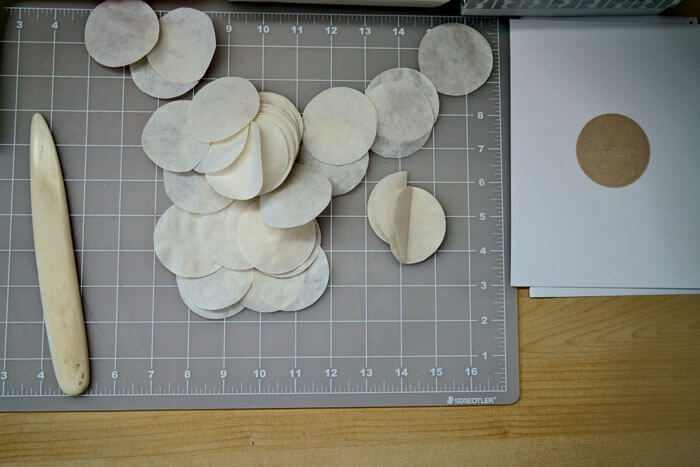
CP: Why are you drawn to pink?
I wish I knew exactly. It feels like a powerful color to me. It has a lot of feminine associations, which I completely embrace and am fine with. You know, pink is for girls; blue is for boys. I don’t really care about that as much—it sort of signifies women in some ways, and I think that’s kind of interesting. It’s also something like a marker, like a highlighting color. Like, “Here’s something that’s important.” I think of it in terms of that. But it really is just a personal, instinctive preference; it’s not like there’s a deep kind of story behind it. But I’ve had people ask me, “Are you a feminist? Is that why you use pink?” And, like, I’m absolutely a feminist, but that’s not why I use pink.
LT: Do you ever get bored?
Right now I’m a little stuck with my work, because I’m trying to use circles, and I don’t know how to do it. It feels like my work is changing and shifting, becoming less formal. There’s a certain formal quality to my work in the past. It’s been squares and rectangles and a kind of minimal visual vocabulary that I find very calm. It’s been cultivated, and it’s on purpose. But I’m finding I want my work to have a little bit more of a visceral quality, a messier, more organic quality, and so I’ve been trying very hard how to figure out how to use circles. It’s quite challenging, so one of the things I’ve done is make up a bunch of handmade paper. My background is in handmade paper. I made all these handmade paper circles. I was going to cut these out and use them in drawings. I really like this kind of rough, deckled edge and that’s something I’m really interested in.
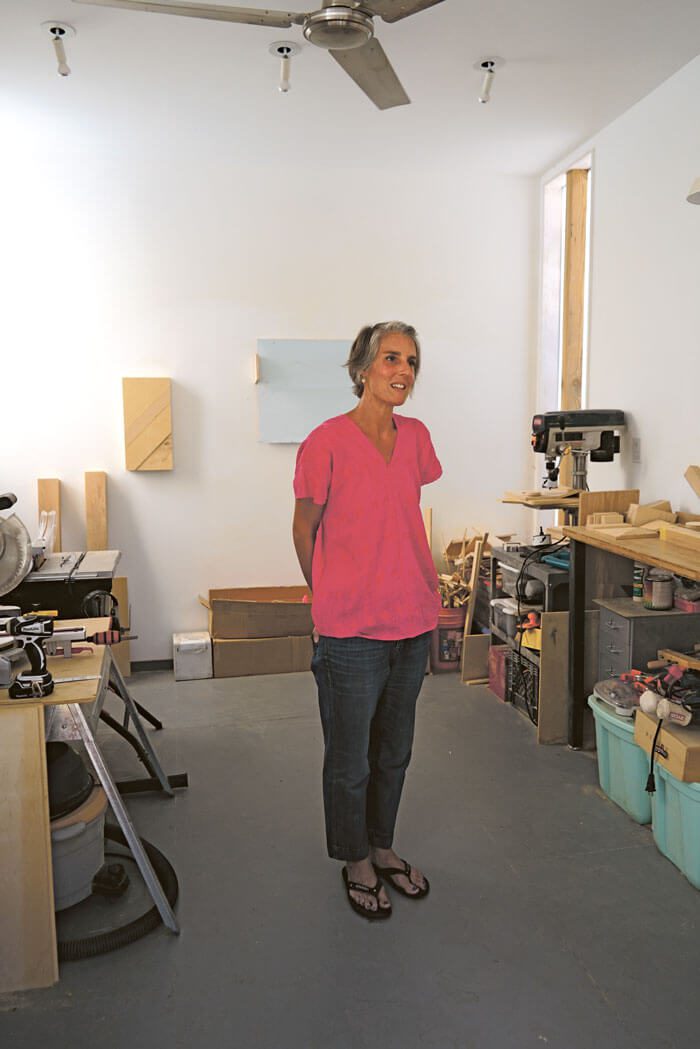
I wouldn’t say that I’m bored, but it’s almost like learning a different language. Like I was speaking Spanish and all of a sudden it’s, “Oh, I want to learn French. That should be no problem.” And it’s a huge problem. Everything is different about using circles, so that’s been a real challenge for me. I’m not giving up on it, but it’s been something like, how’s that going to work? How’s that going to arrive in the same place, where I see the finished piece, and I’m like, “Yes, that’s one of my pieces! That’s it!”? It still feels like someone else’s work. I don’t know if you’ve had that experience, working, when you’re using something, and you’re like, “That’s not me yet.”
There’s so much repetition that the mind can get clear. Like stacking wood, over and over again, or sanding, over and over again.
I would say that there is the kind of calming, meditative quality with a lot of the process that I do. There’s so much repetition that the mind can get clear. Like stacking wood, over and over again, or sanding, over and over again. I find it very centering, calming, and clearing, kind of like a meditation practice. But then there are also times when you’re wrangling and sweating, and it’s not so calm and beautiful and easy. But there are moments of “Oh, yes!” I think that’s where I started with stacking, because I want to be as straightforward and clear as I can be with my work. I don’t want it to be tricky or mysterious. I just want to be like, “This is how it’s made. This is what it’s made from.” It is very clear what this is: the colors, the shape. But it has this kind of transformative quality, while staying as simple as possible. It’s really hard to define what those parameters are. I think that’s very individual for each artist. I’m constantly looking for that.
CP: What do you have coming up next?
I’m really on the circle train, having a hard time. That’s honestly where I am with my work. I could keep repeating myself over and over and over again. I know how to make these angled pieces; I know how to make the pieces that I’ve already made before. I think that’s partly why I’m a sculptor and not a printmaker: I actually don’t want to repeat myself. I’m not very interested in having editions. By the time I’ve figured something out—even if it was very hard to figure out and took a long time and required a lot of effort and new tools—I’m usually on to the next thing. That’s kind of where I’m at right now. And it may not work. We often have these passions, or these rabbit holes we go down, and it may not be there. But it’s still keeping me interested, keeping me fascinated, and just because there isn’t a final product I can show from it, it seems okay to me.
